You heard me right. Last Click Attribution (LCA) is dead.
This isn’t one of those hoaxes like with Andy Kaufman or SEO.
LCA was a doomed model for a number of reasons. But for me, it no longer applies to the world we live in now. And it barely applied before.
LCA will only stay dead, though, if we can decide on its successor.
I’ll get to that.
But first, a little history lesson.
The Last Click problem
When web analytics was in its infancy, LCA worked. People could only reach your site so many ways. You had word-of-mouth. And you had, maybe, a house email list.
That was kinda it.
Search engines were still in a relative stone age. The results weren’t super great and AdWords hadn’t even considered quality score yet. Social networks were crawling out of the primordial ooze. I hadn’t even heard of MySpace yet. Blogging platforms like WordPress hadn’t really taken shape. Plus, there weren’t a lot of great email lists you could buy or sponsor.
In light of all that, LCA made sense.
If somebody reached your site, the last place they reached it from was probably also the first. So it was logical to give the last click credit for a lead or a sale.
But now? The ways people can reach your site are virtually endless.
Search engines have employed machine learning to provide you almost predictive results based on your apparent intent, current location and search history. AdWords has so many different ad formats I’ve lost track.
Social networks have reached critical mass. Even my Grandmother has a Facebook profile. They’re faster sources of news for us than Newspapers or TV.
That doesn’t even factor in the growth of the web and potential sites that could write about your business. Or the growth of mobile apps!
Google did a study in 2012 where they looked at the purchase journeys of 3,000 shoppers across a number of verticals.
All 3,000 of them took different paths to that purchase.
Would that have happened in 2006? I doubt it. Would that have happened in 2000? No chance.
So today, with all those different paths, how could LCA possibly measure which channels should get credit for a sale?
It can’t.
How did Last Click survive?
We kept it alive.
It’s the default in Google Analytics and a number of other analytics platforms.
The status quo is easy. The status quo is comfortable.
All my historical reports are LCA. Introduce another attribution model and it feels like revisionist history—even if the revisions are (*gasp*) more accurate.
LCA does a really great job showing us our brand equity in each channel. Closing clicks come after people are aware of your product or service and you’ve persuaded them to commit.
That commitment is nice. Ultimately, though, it’s patting yourself on the back.
LCA does a really poor job showing us our brand growth in each channel. Which clicks are introducing and persuading people to buy in the first place? LCA is blissfully ignorant on that count.
If it’s ignoring all but the bottom of the marketing funnel, why in the hell are we basing our budgets and ROI on it?
I think it’s time we paid our respects and moved on.
Okay, Last Click sucks. What now?
LCA is dead, but where do we go from here? I’ve been mulling this over for a while.
I started by taking Portent client data over the last year and running it under different attribution models and looking at two things:
- % Change from LCA by Channel
- $ Change from LCA by Channel
Big shout out to Tim Gillman (a.k.a Timtern) for pulling the raw data on this.
My goal was to settle on a model that is aware of the whole marketing funnel. And one that—more importantly—fits customer behavior.
What did I use for this? Google Analytics’ Attribution Model Comparison Tool. It’s fantastic.
I actually arrived at two different ones for ecommerce and lead generation.
For ecommerce: Position Based Attribution
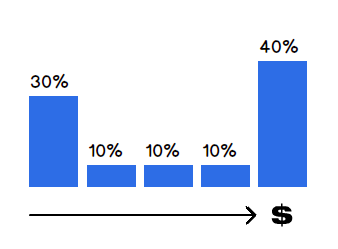
People who buy online are crazy. They open lots of tabs. They go to lots of different sites. They read reviews.
What kind of attribution model solves for ecommerce customers? Position Based Attribution (PBA).
The u-curve model gives nearly equal credit to the first discovery click and last closing click, but it also sprinkles in a little credit for all those flighty comparison shopping clicks in the middle.
% Change from LCA
So how does the PBA model compare to LCA? Which marketing channels get more credit for sales?
- Social Networks—where people get information from their friends—was the biggest winner
- Organic Search—where good content gets you better visibility—also saw huge gains
But % Change doesn’t tell you how much more money each channel was responsible for making.
$ Change from LCA
- Organic Search—content driven—was over $5M more valuable to our clients in 2013 under PBA
- Paid Search—where you can target intent closely—was over $4M more valuable
For lead generation: Time Decay Attribution
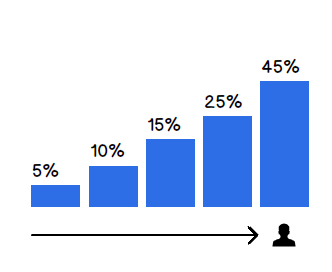
People who fill out lead forms online are a little more pragmatic.
They’re interested in your service, but less impulsive. You have to build trust with them. Especially with expensive services and long-term contracts. With each click, they learn more about you, become more satisfied that you’re the right solution and get more okay with the idea of handing their phone number over to you.
What kind of attribution model solves for lead generation customers? Time Decay Attribution (TDA).
This ramp model gives more credit to a channel as it gets closer to the lead without completely ignoring the clicks that came before it.
% Change from LCA
Which marketing channels get more credit under this model?
- Email—where you can develop a good drip campaign that builds interest in your service—is growing in influence
- Social Networks—much like in the case of ecommerce — get a lot more credit, as one of your friends using a service is a great trust factor
Lead Change from LCA
But again, the % difference versus LCA doesn’t show how many more leads each channel was responsible for driving.
- Referral—especially from review blogs and forums—drove over 3K more leads for our clients in 2013
- Organic Search—where informative content is king—was also a big winner with over 1K more leads
Life after Last Click
I think we can all agree LCA is six feet under. But there are lots of options for attribution models. I’ve posed two that I think are really great here.
Different models reward—and encourage more investment in—channels that are unsung heroes at all points in the marketing funnel.
What models are you using? Let’s work together as marketers to move ourselves (and our clients) on to better attribution in 2014!
Can’t get enough attribution talk? Still confused about how to justify your marketing budget? Check out our Digital Marketer’s Guide to Attribution to learn more.


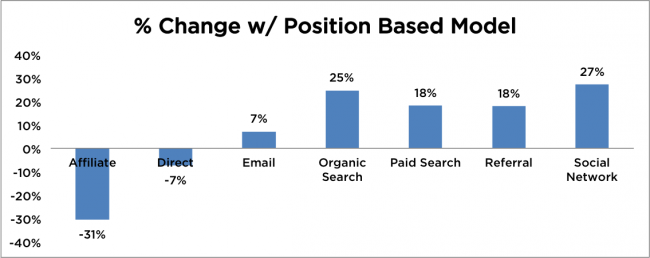
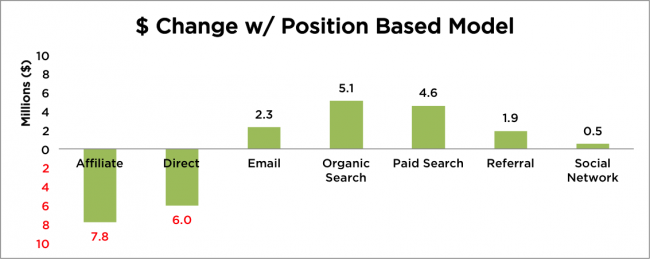
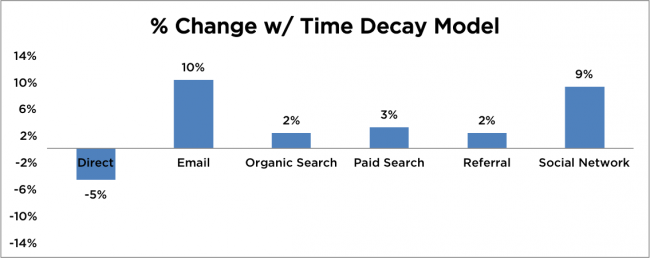
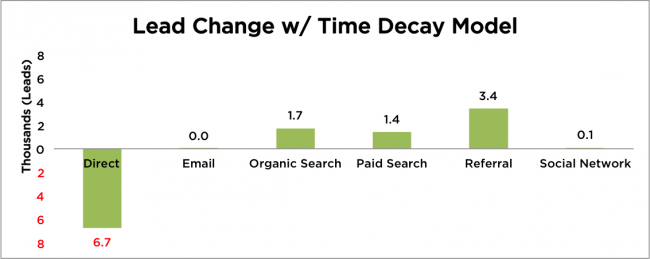








Good post Michael! I agree that the last click model doesn’t always serve us well, although I wouldn’t go as far as to say it’s dead. (Honestly, it probably won’t truly be dead until Google Analytics gives us the ability to choose an attribution model to be applied across all standard reports…please Google??)
Your analysis of the affiliate channel mirrors what we’ve seen with some of our retail clients as well. Coupon sites really change the game here. We’ve done some analysis where we looked at affiliate purchasers, and it turns out a high percentage of them already something in their cart during a prior visit! They get almost finished with checkout and see a coupon code box, and that prompts them to search the web. Consequently, they come back in via an affiliate link and complete the purchase. This behavior royally screws with marketing attribution, and it’s one of the reasons we tell many of our clients that they are over-valuing their affiliate channel.
Your two models are great recommendations for getting past LCA. I’m curious, what do you think of incorporating brand / non-brand keyword data into your models? We’ve played with some models which weight non-brand visits more heavily than brand, and I’m curious your thoughts. (Realizing that this is more difficult with organic now.)
Keep it up, and happy new year!
No kidding, Tyson. I can’t wait for the day when attribution models are liberated from multi-channel funnels and are applicable to the rest of the product.
I’d like to say my biases against affiliate marketing (some of their shadier practices, anyway) influenced this data, but it didn’t. The truth is that people don’t learn about brands through affiliates. They only find deals through affiliates. Retailers will happily keep paying out to them under LCA ignoring the fact that their agency or in-house search teams are busting their asses for the discovery clicks.
As for weighing brand & non-brand separately, I’m not a fan. First of all, it’s damn near impossible with Organic now, as you mentioned. Secondly, just because they came in on a brand keyword doesn’t mean they know who you are, necessarily. They might’ve seen you in passing at a tradeshow somewhere, remembered the name and are just now discovering your site. In that scenario, they’re no less valuable than a non-brand discovery click.
Cheers and here’s to new attribution in 2014!
Michael,
I love how you have put this together. I think this is one of the biggest issues marketers need to work on getting changed in order to really move forward. Granted that no attribution or analytics is perfect, but anything is better than just focusing on first or last click attribution.
The fear of change is huge. Working at a Fortune 500 company they wouldn’t change attribution from a 30 minute session based attribution because they had been including things like #visitors and channel revenue in Annual Corporate filings.
That’s a great (and depressing) point, Bryant.
This blinders-on view of attribution has not only been the default in Analytics platforms forever, but it’s ingrained in high-level business reporting too.
Even if we can’t change attribution models in corporate filings, let’s at least equip ourselves with a better argument for how to use marketing budgets under a non-LCA model.
Nice post. I recently wrote a blog post on this topic as well. The biggest aha to marketers should be that there’s a far better way to properly understand where to allocate their marketing spend. The real question is, will this be embraced. I understand the fear of change as mentioned in other comments, but the fear of not changing should be so much greater!
To be sure, multi-touch/multi-device attribution will explode this year as smart marketers figure out how to make it work for them.
Great post! I’ve been experimenting with different attribution models and agree with pretty much everything you said.
The one thing I question a bit is the affiliate attribution information. We’ve seen some affiliate attribution at the beginning of the funnel and were wondering if it might be caused by comparison shopping? (ie they were looking at competitors first)
It seems there is value in the affiliates when a person is doing price/benefit comparisons of products and finds you on an affiliate page early in the buy cycle. If the first click comes from an affiliate isn’t that as good as a first click from any other source?
The other side of that coin is Tyson’s comment about people having items in their shopping cart already when they hit the affiliate and return to the site. Do you have any data on how frequent the scenario’s are in comparison? (Initial visit generated by affiliate and return visit generated by affiliate?)
One last thought. Are you aware of any affiliate programs that pay based on weighted attribution? So, for instance, if the affiliate were 1st or last they get paid X%, if they were in the middle they would get paid Y%?
Thanks,
Joe
Cards on the table: Portent doesn’t currently work with a lot of affiliates or run affiliate programs for clients.
So I haven’t experimented a lot with what to pay out to them that’s fair, Joe.
But I would certainly suggest basing affiliate payout on an attribution model.
It’s important to note that my findings don’t mean affiliates are losing money for clients. They have value, it’s just not nearly as much as what we’re paying out to them under LCA.
Sweet! This article was super helpful. I’ve played around with the Model Comparison Tool in GA before but didn’t really know what situations the various models should be used for.
Thanks, Michael!
Great article. We have been looking more closely at the E-commerce model you suggest which has also uncovered that affiliates and re-targeting are being over-attributed. This has helped us to move our marketing spend to where it is giving us a better ROI.
Michael, do you have any information on how you can move Google Analytics to the new model? Is it even possible at the moment?
I asked about when they’re going to liberate the attribution models from the MCF section at the Google Analytics Summit last year.
Google said they’re working on it, but didn’t give a timeline. So we can live in hope that it’ll happen someday!
It’s an obvious move, really. Just a matter of time now.
Michael – fantastic post – enjoyed every word – and yes, we should keep LCA dead (you cannot imagine how much trouble I had explaining AdWords to clients and how to calculate ROI properly).
Can’t wait for your future posts on multi-device attribution.
Before the internet – yes, there was marketing back then – we went to incredible lengths to try and track our activities – offer coupons, discount codes, different telephone numbers on different ads, and so on….
Suddenly, the internet gave us a way to track. It was the Holy Grail – I run this ad, and this happens. Google themselves told us a couple of years ago when they published ZMOT that we were getting it wrong – or not as right as we thought we were. And few people listened.
You are right LCA is not as significant as we think it is – or clients think it is. My clients love remarketing – so do I – but I appreciate that you have to get people to your site before you can remarket to them, for example.
The old adage that half my ad spend is wasted, I just don’t know which half, is no longer valid. I do know a lot more than I used to.
I just don’t know everything – I don’t even know as much as I think I do.
But the smart marketer today knows an awful lot more than his 1980 counterpart.
If we acknowledge the path to a purchase is circuitous and varied, then shouldn’t we really be emphasizing the importance of the first click?
PBA does give a lot of credit to the first click, Adolf.
TDA doesn’t give as much, but it isn’t ignorant of first clicks like LCA.
But again, the models I suggest are built around user behavior in each circumstance without giving 0% credit to any step in the online marketing funnel.
Great post Michael…PBA is very useful to us here, especially when evaluating the effectiveness of our influencer and banner advertising that drive a lot of retargeting. Also, thought you were spot on regarding the affiliate numbers, our coupon site members get way too much credit with LCA.
When I used to run sales for a large Top 20 Display Ad Network, we ran campaigns on a CPA basis with some programs paying out a % of the first click (intro), a % for the second to last click (assist) and then a % to the final click (closer). This model seemed to work well for the consumer focused, replenish-able diet product. Payouts for initial purchases (new customers) were higher than for re-orders (existing customers).
Love the second to last click credit piece, Rick.
If your last click is marriage, then second to last click is getting engaged.
The models I propose are just meant to be a jumping-off point.
Hi Michael, This post is awesome! I thought it was so good that I decided to share it on GrowthHackers.com: http://www.growthhackers.com/r-i-p-last-click-attribution-intermediateadvanced-google-analytics/
Quick question regarding the graphs you made…. are those with excel or a third party SaaS website? If you made those with an excel file, do you mind sharing? I would love to be able to use the templates for my own data.
Thanks again!
This is fantastic article and currently I am writing something not too dissimilar.
IMO the industry will struggle to create a ubiquitous methodology for attribution as there are just such a large set of unknowns.
With your described position based attribution you fail to take into account the time on site each click delivers.
Through analysis one of our clients found out that for every additional minute a user spends on site that it is worth an additional amount of money in revenue and profit.
Therefore the time a user spends on site is critical in influencing the customer journey, as not each click to a site is created equal time on site therefore is the governing factor in executing attribution.
Attribution rules
If there is no click activity for a four day period prior to the sale then the sales is deemed organic and no channel is attributed the sale
If there is a click within a four day period of a sale being made then the following attribution model is instigated
5% of Sales Revenue = CPA = Analysis of click path { Channel A (time on siteA / Total time on site)+Channel B (time on siteB/ Total time on site) +Channel N (time on siteN/ Total time on site)}
It is worth noting there are significant known flaws with all current attribution models, under the below conditions attribution modelling falls down completely
• When multiple users use the same computer, attribution tracking cannot identify which user agent is using the computer at any one time
• When first and third party cookies are deleted are blocked by a browser
o Approximately 28 percent of Internet users in Australia delete their first-party cookies in a month. Third-party cookie percentages are even higher, with nearly 37 percent of Internet users deleting their third-party cookies in a month. http://www.comscore.com/Insights/Press_Releases/2011/2/comScore_Publishes_White_Paper_on_the_Impact_of_Cookie_Deletion_on_Website_Audience_Measurement_in_Australia
• When a single user uses multiple devices to complete a purchase, currently attribution systems are not sophisticated in pairing multiple devices to a single user
• If a user is a member of a cashback or loyalty points scheme any advertiser who wants to implement attribution and engage these type of audiences must have a hierarchical structure that can supersede attribution in order to give a constant monetary value to these type of transactions
Every industry, brand, segment and sometimes even products have a different purchase paths and as such require their own customised attribution model.
And this is the problem with defining standard media attribution models. Because your businesses are unique, with unique products, strategies, competitors and environments, picking a cookie cutter (pardon the pun) attribution model based on an industry average can potentially be as misleading as last click attribution.
The only way to guarantee attribution models are accurate and thus can be utilised for major strategic decisions such as media budget allocation between channels is to use a custom attribution model.
This is great, Chris.
Ultimately, more folks are going to have to adopt Universal Analytics and do session stitching across devices for a true modern attribution conversation to happen.
But until then, we can do better than LCA for attribution on a single device purchase path.
The idea of any “attribution” is passé. If organizations break down internal silos (search (SEO/PPC), display, social, demand gen, email, etc.) and have each group work towards one goal (i.e., “grow the business), than there’s no need to worry about what channel gets “credit” for driving a lead or a sale.
A good idea, Rob.
But the reality is your silo will get a budget and that silo will be based on something. Just don’t base your budget on LCA, is all I’m saying. Let’s get more sophisticated.
Hi Michael,
Interesting article, and i agree that LCA is dead. Not convinced your proposed U-curve approach is right – how do you know we should give ‘nearly equal credit to the first discovery click and last closing click, but sprinkle a little credit around for comparison shopping clicks in the middle’? A substantial portion of prospects may be most convinced by such ‘intermediate’ comparison shopping information. I also dislike unfounded statements like ‘the truth is people don’t learn about brands through affiliates’ Again, how do you know this is true for all prospective customers?
What is the point of all this subjective guesswork? Why don’t we use good old time series regression to attribute sales lifts to increased clicks among a dozen advertising forms? Online has the benefit of very frequent data – let’s use it!
Cheers
Koen Pauwels
A fair point, Koen.
To which I’d answer, I don’t know it’s true for all prospective customers. And I can’t know because I don’t read minds. I’m going off of trends I see in aggregate.
The customer doesn’t know your brand and you aren’t part of the comparison shopping process unless they find you. That’s why you give credit to first click. Middle clicks are usually short back and forth to check prices between other sites.
Rick Noel had a great idea in this thread to bump up credit for the second to last click. That could solve for middle clicks being a bit more influential.
My point in writing this is just to posit models to get us, as an industry, away from LCA as the default. The model you decide on can be completely unique to your business.
Good post. It should also be noted that last click is only half the problem. Last view can be equally short-sighted and is suspect to retargeting abuse. Marketers that are looking to target new in-market prospects need something more sophisticated. Good news: it’s out there. (Note: We don’t sell attribution, but we can help performance marketers understand it better.)
Great theory Michael.
Particularly useful when trying to influence client buy-in into channels they do not regard as profitable due to their consistent referencing of LCA reports (mainly because they are easy to access in GA and understand).
For proving value of channels that adopt much longer sales cycles (such as social) this type of reporting is of great importance.
There’s more than one cog in a well oiled machine!
Hi Michael, great article. I just think that today with the huge amount of data available (Big Data), it’s wrong to re-attribute starting with assumptions based on the client’s vertical or maybe about some sample of users’ paths.
Today on the market are available tools and algorithms that allow clients and agencies to have and put in place a real and concrete Data Driven approach and let the clients’ “data speaks”.
To fully adopt a new currency you need to have a totally trusted and actionable new metrics that is MTA (Mutli Toch Attribution).
What do you think about?
Best
The future is certainly data driven attribution models.
But you have to crawl before you can walk. Heh!
You are spot on when you point out that Last Click Attribution is dead and that the “status quo is comfortable.” We see that as one of the #1 reasons that marketers haven’t pursued holistic marketing measurement. While I agree that for certain marketers, fixed attribution models can make sense, there’s other non-static options for measurement. While the two models you propose are BETTER than last click, I think that rather than just looking at the % or $ difference from last click, marketers need to also think about looking at how attribution results improve over time. Advanced Attribution models allow marketers to pursue a data driven approach that evaluates a marketer’s individual data set to find what efforts are driving conversions. This is beneficial because as you change the media mix and pull levers to improve your media, you aren’t just applying a static set of rules to evaluate, you are actually seeing if those changes influence your overall conversion rates individually. If you have a complex media mix where you are making constant changes and optimizations, this is definitely an option to consider.
– Natasha Moonka, Product Marketing Manager, Adometry
Whole-heartedly agree, Natasha. Data driven should be the present.
Michael,
You should correct your article as Google analytics currently uses Last Non-Direct Click attribution they confirm that on their help pages:
https://support.google.com/analytics/answer/1665189?hl=en
“The Last Non-Direct Click model ignores direct visits and attributes 100% of the conversion value to the last channel that the customer clicked through from before buying or converting. Google Analytics uses this model by default when attributing conversion value in non-Multi-Channel Funnels reports.”
Probably they made the change last year or at the end of 2012, but it has been that way for an year and a half now.
Correct, Dan. But it’s inconsistent throughout the product. In the Multi-Channel Funnels section, for instance, it’s true LCA by default. And in the rest of the product it’s LNDCA.
Doesn’t change the fact that no credit is being given to upper or middle funnel visits in the click stream.
The death of LCA is probably here, but I fear a lot of vendors/agencies and even Google themselves are going to start using this as a cop-out for underperforming and/or insanely competitive keywords that aren’t providing the same value they used to.
Not happy with a CPA 30% above your target for that Adwords campaign or the fact that your CPC is double what it was last year? Well your just not looking at the “big picture” will be the default answer that some of the unscrupulous agencies/vendors/Google will use to try and convince people that the bad last click numbers they’re seeing are “ok”…
Good marketers are really going to have to get their data in order to track this stuff to make sure they’re actually getting a return on their marketing spend and not just some imaginary lift on “brand awareness”.